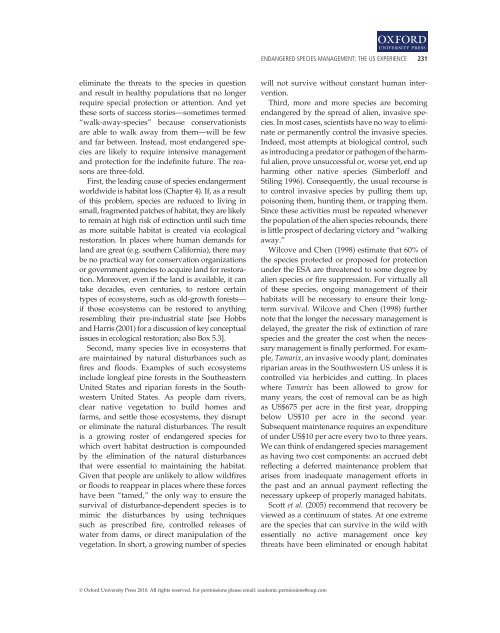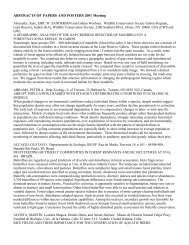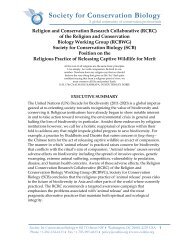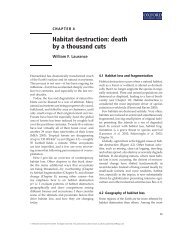Endangered species management: the US experience - Society for ...
Endangered species management: the US experience - Society for ...
Endangered species management: the US experience - Society for ...
You also want an ePaper? Increase the reach of your titles
YUMPU automatically turns print PDFs into web optimized ePapers that Google loves.
1<br />
ENDANGERED SPECIES MANAGEMENT: THE <strong>US</strong> EXPERIENCE 231<br />
eliminate <strong>the</strong> threats to <strong>the</strong> <strong>species</strong> in question<br />
and result in healthy populations that no longer<br />
require special protection or attention. And yet<br />
<strong>the</strong>se sorts of success stories—sometimes termed<br />
“walk-away-<strong>species</strong>” because conservationists<br />
are able to walk away from <strong>the</strong>m—will be few<br />
and far between. Instead, most endangered <strong>species</strong><br />
are likely to require intensive <strong>management</strong><br />
and protection <strong>for</strong> <strong>the</strong> indefinite future. The reasons<br />
are three-fold.<br />
First, <strong>the</strong> leading cause of <strong>species</strong> endangerment<br />
worldwide is habitat loss (Chapter 4). If, as a result<br />
of this problem, <strong>species</strong> are reduced to living in<br />
small, fragmented patches of habitat, <strong>the</strong>y are likely<br />
to remain at high risk of extinction until such time<br />
as more suitable habitat is created via ecological<br />
restoration. In places where human demands <strong>for</strong><br />
land are great (e.g. sou<strong>the</strong>rn Cali<strong>for</strong>nia), <strong>the</strong>re may<br />
be no practical way <strong>for</strong> conservation organizations<br />
or government agencies to acquire land <strong>for</strong> restoration.<br />
Moreover, even if <strong>the</strong> land is available, it can<br />
take decades, even centuries, to restore certain<br />
types of ecosystems, such as old-growth <strong>for</strong>ests—<br />
if those ecosystems can be restored to anything<br />
resembling <strong>the</strong>ir pre-industrial state [see Hobbs<br />
and Harris (2001) <strong>for</strong> a discussion of key conceptual<br />
issues in ecological restoration; also Box 5.3].<br />
Second, many <strong>species</strong> live in ecosystems that<br />
are maintained by natural disturbances such as<br />
fires and floods. Examples of such ecosystems<br />
include longleaf pine <strong>for</strong>ests in <strong>the</strong> Sou<strong>the</strong>astern<br />
United States and riparian <strong>for</strong>ests in <strong>the</strong> Southwestern<br />
United States. As people dam rivers,<br />
clear native vegetation to build homes and<br />
farms, and settle those ecosystems, <strong>the</strong>y disrupt<br />
or eliminate <strong>the</strong> natural disturbances. The result<br />
is a growing roster of endangered <strong>species</strong> <strong>for</strong><br />
which overt habitat destruction is compounded<br />
by <strong>the</strong> elimination of <strong>the</strong> natural disturbances<br />
that were essential to maintaining <strong>the</strong> habitat.<br />
Given that people are unlikely to allow wildfires<br />
or floods to reappear in places where <strong>the</strong>se <strong>for</strong>ces<br />
have been “tamed,” <strong>the</strong> only way to ensure <strong>the</strong><br />
survival of disturbance-dependent <strong>species</strong> is to<br />
mimic <strong>the</strong> disturbances by using techniques<br />
such as prescribed fire, controlled releases of<br />
water from dams, or direct manipulation of <strong>the</strong><br />
vegetation. In short, a growing number of <strong>species</strong><br />
will not survive without constant human intervention.<br />
Third, more and more <strong>species</strong> are becoming<br />
endangered by <strong>the</strong> spread of alien, invasive <strong>species</strong>.<br />
In most cases, scientists have no way to eliminate<br />
or permanently control <strong>the</strong> invasive <strong>species</strong>.<br />
Indeed, most attempts at biological control, such<br />
as introducing a predator or pathogen of <strong>the</strong> harmful<br />
alien, prove unsuccessful or, worse yet, end up<br />
harming o<strong>the</strong>r native <strong>species</strong> (Simberloff and<br />
Stiling 1996). Consequently, <strong>the</strong> usual recourse is<br />
to control invasive <strong>species</strong> by pulling <strong>the</strong>m up,<br />
poisoning <strong>the</strong>m, hunting <strong>the</strong>m, or trapping <strong>the</strong>m.<br />
Since <strong>the</strong>se activities must be repeated whenever<br />
<strong>the</strong> population of <strong>the</strong> alien <strong>species</strong> rebounds, <strong>the</strong>re<br />
is little prospect of declaring victory and “walking<br />
away.”<br />
Wilcove and Chen (1998) estimate that 60% of<br />
<strong>the</strong> <strong>species</strong> protected or proposed <strong>for</strong> protection<br />
under <strong>the</strong> ESA are threatened to some degree by<br />
alien <strong>species</strong> or fire suppression. For virtually all<br />
of <strong>the</strong>se <strong>species</strong>, ongoing <strong>management</strong> of <strong>the</strong>ir<br />
habitats will be necessary to ensure <strong>the</strong>ir longterm<br />
survival. Wilcove and Chen (1998) fur<strong>the</strong>r<br />
note that <strong>the</strong> longer <strong>the</strong> necessary <strong>management</strong> is<br />
delayed, <strong>the</strong> greater <strong>the</strong> risk of extinction of rare<br />
<strong>species</strong> and <strong>the</strong> greater <strong>the</strong> cost when <strong>the</strong> necessary<br />
<strong>management</strong> is finally per<strong>for</strong>med. For example,<br />
Tamarix, an invasive woody plant, dominates<br />
riparian areas in <strong>the</strong> Southwestern <strong>US</strong> unless it is<br />
controlled via herbicides and cutting. In places<br />
where Tamarix has been allowed to grow <strong>for</strong><br />
many years, <strong>the</strong> cost of removal can be as high<br />
as <strong>US</strong>$675 per acre in <strong>the</strong> first year, dropping<br />
below <strong>US</strong>$10 per acre in <strong>the</strong> second year.<br />
Subsequent maintenance requires an expenditure<br />
of under <strong>US</strong>$10 per acre every two to three years.<br />
We can think of endangered <strong>species</strong> <strong>management</strong><br />
as having two cost components: an accrued debt<br />
reflecting a deferred maintenance problem that<br />
arises from inadequate <strong>management</strong> ef<strong>for</strong>ts in<br />
<strong>the</strong> past and an annual payment reflecting <strong>the</strong><br />
necessary upkeep of properly managed habitats.<br />
Scott et al. (2005) recommend that recovery be<br />
viewed as a continuum of states. At one extreme<br />
are <strong>the</strong> <strong>species</strong> that can survive in <strong>the</strong> wild with<br />
essentially no active <strong>management</strong> once key<br />
threats have been eliminated or enough habitat<br />
© Ox<strong>for</strong>d University Press 2010. All rights reserved. For permissions please email: academic.permissions@oup.com






